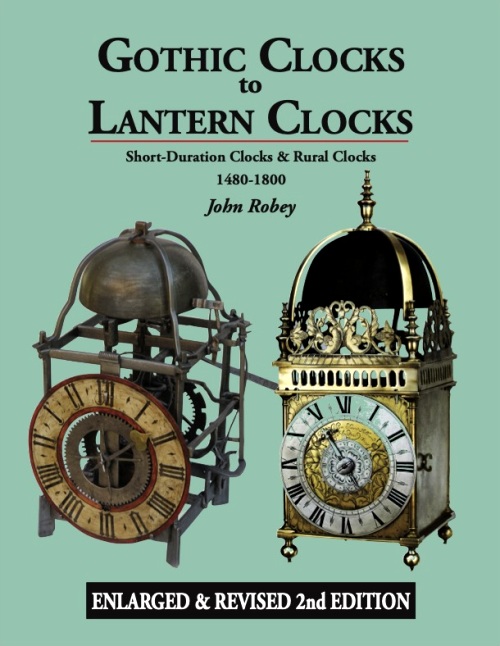
Gothic Clocks to Lantern Clocks - Short Duration Clocks and Rural Clocks 1480 - 1800
Author: John Robey
424 pages, almost 2,000 colour illustrations. Second edition.
The earliest mechanical clocks were installed in the towers of European churches and other public buildings, often with more emphasis on astronomical displays than timekeeping. By the fourteenth century small clocks for domestic use became more widespread, initially being simple timepieces or alarms. These developed into elaborate iron clocks based on gothic styles of architecture, with painted iron dials, and usually striking the hours on a bell, or even striking the quarter hours on an additional bell.
These clocks were bought by the wealthy throughout Europe, including Britain, but by the start of the seventeenth century English clock makers developed the lantern clock, made mostly of brass with engraved dials, to replace Continental iron clocks, which had become regarded as old fashioned and unreliable. The focus of clockmaking then shifted from Germany to England.
Iron clocks were still made, especially for the less well-to-do, and continued as rural clocks until the early nineteenth century. While Gothic clocks and early lantern clocks are widely studied and collected, less attention has been paid to later rural and short-duration clocks, with little information in print. Gothic Clocks to Lantern Clocks aims to remedy this by discussing a wide range of clocks, many of them being unique examples or having unusual and interesting features, many of which are quite different to those on English clocks. Since they are mostly unsigned, regional technical characteristics have to be used to establish their origins, and there is much emphasis on constructional and technical features, while not neglecting the design of the dials.
An introductory chapter discusses the three main types of Gothic clock, details and variations of strip frames and posted frames, wheels, hour and quarter striking, bells and dials. Five chapters describe and illustrate Germanic clocks, Italian clocks, French and Flemish clocks, English clocks and Swedish clocks. Each has up to thirty colour illustrations, as well as wheel counts and dimensions. Restorations, reproductions, replicas and fakes are also discussed, followed by appendices, an annotated bibliography and an index.
Almost 2,000 full-colour illustrations, mainly taken by the author, and with much technical and other information never before published.